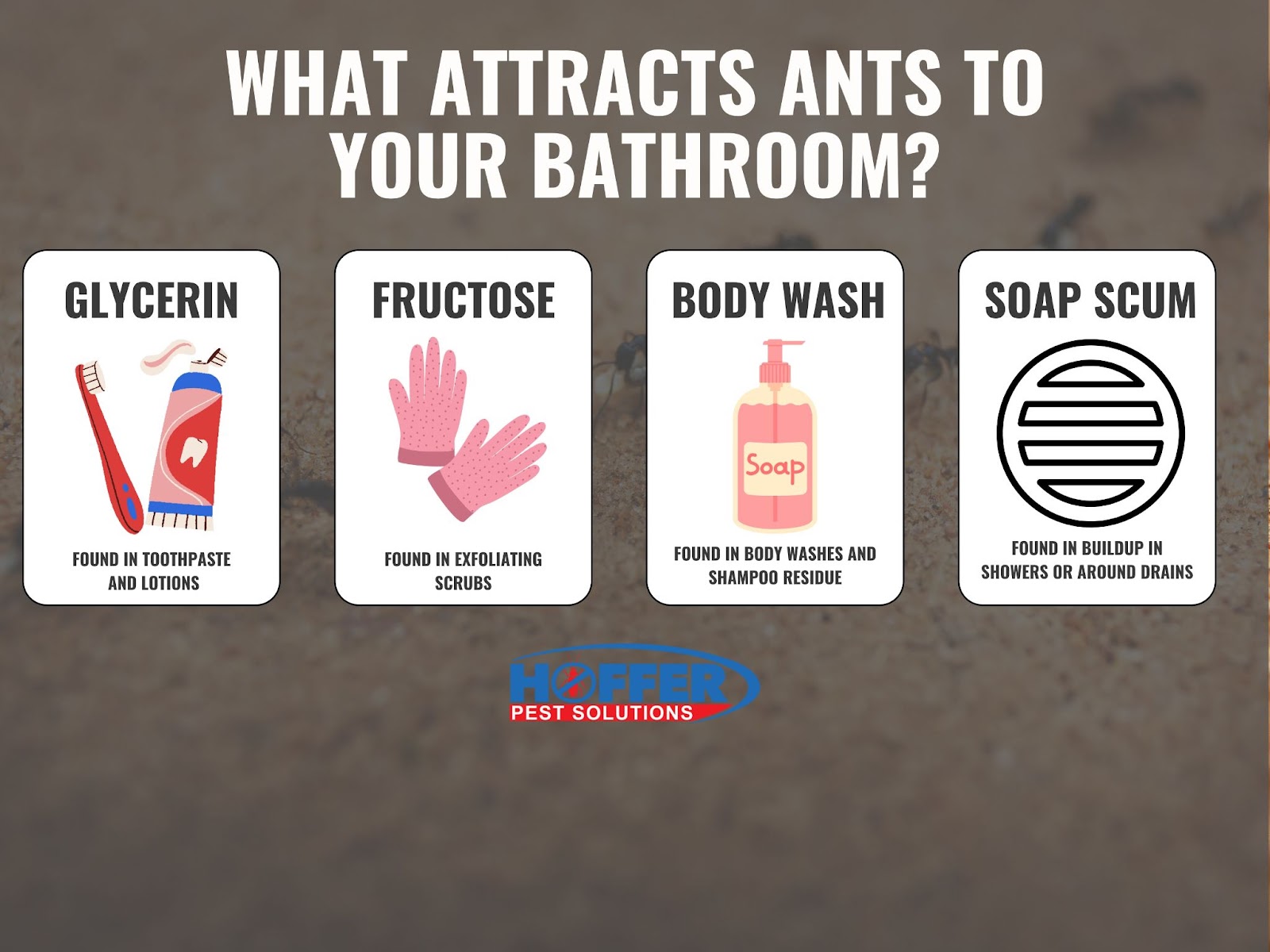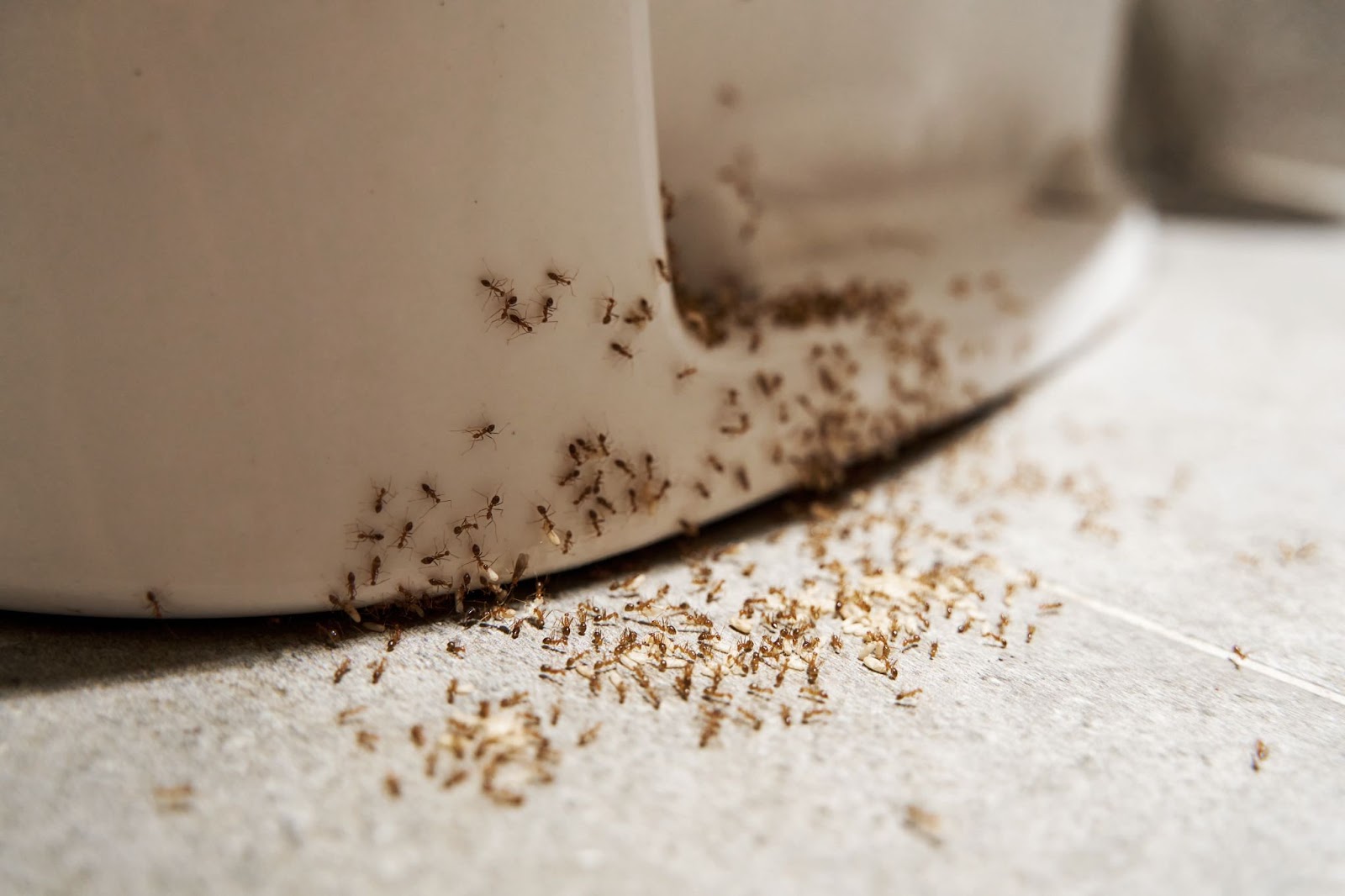You scrub, you clean, and yet, ants. Again.
In Florida’s endless humidity, your bathroom is basically a luxury resort for tiny ants chasing moisture, warmth, and even sweet-smelling soap. And no, they’re not just after crumbs.
If they keep coming back, it’s because the root cause hasn’t been solved, yet. Here’s how to finally kick them out and keep them out for good.
Most Popular Florida Ants That Invade Bathrooms
If you're spotting a parade of tiny ants in your bathroom, odds are you're dealing with one of three main culprits and identifying which one is key to stopping them for good.
Ghost Ants
Ghost ants in Florida are tiny, with a dark head and pale, almost translucent abdomen. They move in erratic, unpredictable patterns, often making them difficult to trace. And here's a fun fact that surprises a lot of homeowners: when crushed, ghost ants release a faint coconut-like odor. It's weird, yes but oddly distinctive.
What makes ghost ants especially tough is their ability to split into sub-colonies when threatened, a survival tactic known as "budding." Spray the wrong product, and instead of killing them off, you might accidentally create two new colonies hiding deeper in your walls.
More Information on How to Get Rid of Ghost Ants in Florida: Here
🐜 Pharaoh Ants
These ants are slightly larger, with a pale yellow or reddish tint, and are notorious for infesting hospitals, apartments, and older homes. Pharaoh ants in Florida thrive in warm, humid interiors and are especially difficult to eliminate once they've established multiple nests.
White-Footed and Sugar Ants
White-footed ants and sugar ants are often misidentified as "harmless" household ants but in truth, they can be just as persistent. Sugar ants are drawn to the same sweet-smelling products we use in bathrooms, from shampoo to toothpaste. And white-footed ants, while less aggressive, form massive colonies that can number in the hundreds of thousands.
Why Do Ants Love Your Clean Bathroom?

You mop, you scrub, you disinfect. So why are ants still turning your bathroom into their personal playground?
Here’s the surprising truth: cleanliness isn’t the issue. Moisture is.
Moisture Is More Tempting Than Leftovers
Bathrooms present an entirely different kind of buffet; one made of humidity, condensation, and microscopic organic residue.
Ants, especially ghost ants, are drawn to water more than crumbs. And in a Florida bathroom, moisture is hard to avoid. We’ve inspected bathrooms where the culprit wasn’t rotting wood or sticky spills, it was a minor leak under the vanity or a wet bath mat that never fully dried. If your bathroom holds onto humidity, you’re likely hosting an open invitation to these six-legged squatters.
It’s Not You, It’s the Climate
Unlike northern states where ant activity slows dramatically in cold weather, our tropical climate keeps colonies active all year long. That means ants continue building, foraging, and reproducing, even in January.
So even if your cleaning routine is meticulous, Florida’s warmth and moisture keep the environmental conditions ideal for ants, particularly in areas like bathrooms and laundry rooms where water use is constant. If you’ve moved from up north recently, this year-round pest pressure might come as an unpleasant surprise.
Surprising Ant Attractants in Bathrooms
Let’s dig a little deeper. You’ve fixed leaks, turned on the exhaust fan but still, they return. Why?
The answer might be in your self-care products.
Ants are incredibly sensitive to sugar-based or scented ingredients, many of which are found in everyday bathroom items:
Glycerin in toothpaste and lotions
Fructose in exfoliating scrubs
Sweet or fruity body washes and shampoo residue
Soap scum buildup in showers or around drains
This leads us to a popular question we hear:
“Could my lotion or soap be causing this?”
Yes, especially if it contains natural sugars or sweet-smelling fragrances. To an ant’s sensory system, that citrus-sugar body wash might as well be a dessert tray.
In short, it’s not a cleanliness problem. It’s a chemical and moisture one.
Why DIY Doesn’t Always Work (And How to Make It Work)
DIY ant hacks can feel like a game of whack-a-mole; spray one day, they’re back the next. That’s because most quick fixes miss the why behind the infestation. But with the right approach (and a little strategy), you can turn your DIY game from frustrating to foolproof.
Let’s start with what not to do.
Killing Scout Ants on Sight
Here's the catch: those scouts are actually valuable intel. When you kill them, you erase their trail and lose the opportunity to follow them back to the source, that’s why the colony stays untouched.
Using Over-the-Counter Repellents
Those store-bought sprays promise fast results, and they often deliver on the surface. What you don’t see is that repellent sprays signal danger to the colony, prompting it to split into multiple sub-colonies. And if you’ve ever asked, “Why are they still here even after I sprayed everywhere?”, now you know.
Inconsistent Baiting
Baiting works but only if it’s done right. If you lay down ant bait in one spot and spray everywhere else, or if you interrupt the process too soon, the ants may abandon the bait without taking it back to the colony. Worse, this inconsistency can lead to budding behavior, where the colony fractures and multiplies.
The Right Way to DIY Ant Control
Now let’s talk about what actually works and works safely and strategically.
Use Slow-Acting Baits
Products like Terro or other borax-based gels are your best bet. These baits contain a sweet attractant that ants carry back to the colony. Because the toxin is slow-acting, the foragers have time to share it before it starts to kill them, wiping out the colony from within.
Be Patient and Don’t Spray While Baiting
This is a big one: don’t spray ant trails or nests while baiting. If you interfere, you’ll scatter the colony or kill off only the scouts. Allow at least 7–10 days for the bait to do its work.
Try Natural Remedies In the Right Places
If you’re worried about using chemicals around kids or pets (a worry hear all the time), natural alternatives can supplement your baiting plan:
Vinegar Spray: Disrupts trails but doesn’t kill, best used after baiting.
Peppermint or Tea Tree Oil: Soaked cotton balls placed near entry points repel ants naturally.
Diatomaceous Earth (food-grade only): Dust this into cracks and behind baseboards. It slices into ants’ exoskeletons, dehydrating them over time. Chemical-free and effective.
Just remember: natural doesn’t always mean instant, and these methods work best as part of a broader strategy not as a standalone fix.
If you’ve tried DIY before and feel frustrated, you’re not alone. It’s not about effort—it’s about knowing what actually works. And in Florida, with ghost ants that split colonies at the first sign of stress, strategy matters more than strength.
Why They Keep Coming Back (And How to Stop It Permanently)
If you’ve ever thought, “I just got rid of these ants, why are they back already?” It's a solid question. Many Florida homeowners experience repeat ant invasions, especially in bathrooms. The reason? The problem wasn’t solved at the colony level.
Get to Know Colony Behavior in Florida’s Ants
In South Florida, ghost ants are the dominant invaders, and their colony structure makes them uniquely persistent. Unlike other ants that operate under a single queen, ghost ants often have multiple queens. That means they can split into several sub-colonies, especially if they sense danger.
So, what happens when you only treat part of the infestation?
You might eliminate one visible trail or kill off some foragers, but the queens survive. And within days, those queens are producing more workers in deeper, less accessible areas.
Why Humidity Control Matters
Eliminating ants is also about making your home less inviting to begin with. And in Florida, that starts with moisture control.
Use Exhaust Fans and Dehumidifiers
Bathrooms without proper ventilation become ant magnets. After every shower or bath, run the exhaust fan to reduce lingering moisture. If your bathroom tends to stay humid (especially in older homes without central airflow), consider using a small dehumidifier to maintain a dry environment. Ants, particularly ghost ants, are drawn to dampness. Remove the moisture, and you remove the magnet.
Fix Structural Water Damage
You might not even know it’s there, but ants do. Softened wood behind the vanity, warped baseboards, or old drywall with water stains are prime nesting spots. Ghost ants are tiny enough to sneak into these spaces, set up shop, and remain undetected until you see another trail. Fixing and replacing damaged wood is one of the most effective long-term prevention strategies.
If your bathroom has old tile, loose grout or cracked caulking could also be creating access points into wall voids where colonies hide. Even small imperfections can become major vulnerabilities.
When It’s Time to Call a Pro
If you’ve baited consistently for more than a week and still see ants, it’s time to bring in professional ant control.
Why?
Because certain infestations (especially those involving ghost ants with hidden satellite colonies) can’t be fully addressed with over-the-counter methods. Professional inspections include moisture detection, wall-void exploration, and bait positioning that reach the colony without triggering stress reactions that cause splitting.
Our local technicians know well how Florida’s heat, humidity, and structural quirks affect ant behavior, and above all, how to get ahead of it.
If you’re seeing ants reappear season after season, even after everything you’ve tried, know this: it’s not a reflection of your efforts, it’s the nature of the pest. And with the right plan, the cycle can be broken.


